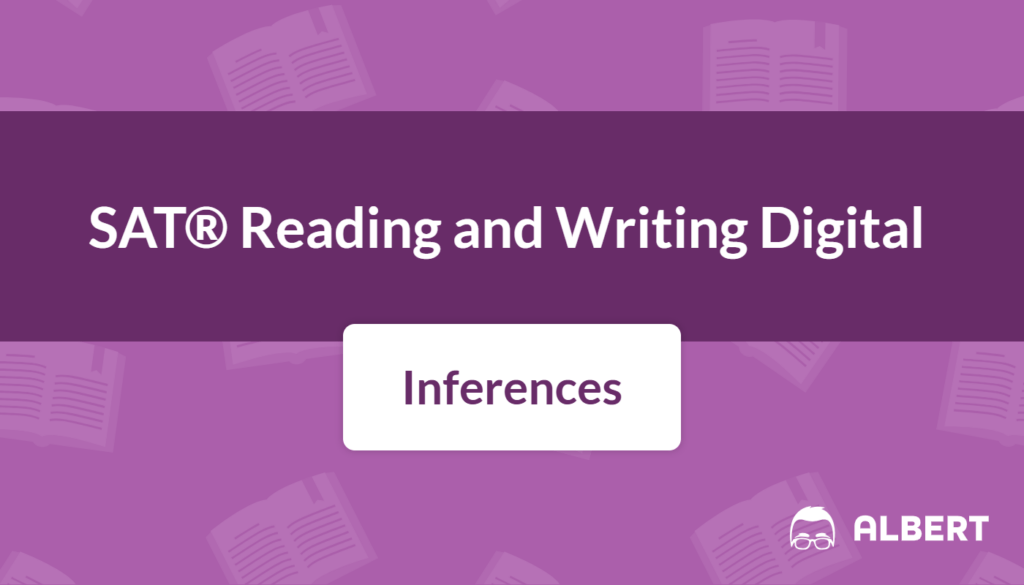What We Review
Understanding Inferences for the SAT® Reading and Writing Test
Colleges want to see that you can use comprehension, analysis, and reasoning skills. On test day, there will be questions asking you to fill in the blank with the answer choice that most logically completes the text. This means you must locate details, interpret what the author suggests, make inferences, and draw informed conclusions.
Making inferences is a key skill tested in the SAT® Reading and Writing Test. Students often face passages where the answer is not stated outright. Therefore, solid inference skills help in understanding the hidden or implied meanings in a text.
Strong reading comprehension relies on noticing both explicit statements and subtle suggestions. Consequently, practicing how to make inferences will improve your ability to interpret complex texts quickly and accurately.
What Are Inferences?
An inference is a conclusion formed by closely examining what you read and connecting that evidence with your existing knowledge. Many passages contain details that hint at a deeper meaning. However, authors might not come right out and say these hints directly. Instead, they embed them in descriptions, dialogue, or context.
When making inferences, you look for implicit meanings. These are ideas suggested but not clearly stated. For instance, if a story describes someone shivering in a brightly lit room, you might infer that the character is nervous instead of cold.
Example: Understanding Implicit Information
Sample Text:
“Jamie clenched the steering wheel, eyes darting to the rearview mirror as flashing lights approached.”
Step-by-Step Solution:
- Read Carefully: Notice Jamie’s reaction (clenching the steering wheel).
- Identify Key Ideas: “Eyes darting” and “flashing lights” suggest tension or fear.
- Look for Clues: A driver seeing flashing lights often signals fear of being pulled over.
- Combine Information: Jamie might be anxious about law enforcement. This is not stated outright, but the clues lead to this inference.
Practice Problem:
“The floor was covered in footprints, and the window by the desk was open despite the chilly weather.”
Question: What can you infer about the room?
- Try applying the same four steps. The answer might relate to an intruder or a recent departure under rushed conditions.

How to Make Inferences
With the SAT® Reading and Writing Test, you will often use these steps to uncover deeper meanings. Test questions may ask you to fill in the blank with an answer choice that most logically completes the text. Therefore, a practical method becomes crucial.
- Read the Passage Carefully
- Skim for main ideas, then reread important parts. This helps you notice any subtle clues.
- Identify Key Ideas and Details
- Pay attention to repeated words, descriptive phrases, or anything that signals a change in tone.
- Look for Clues and Context
- Consider the author’s tone, word choice, and the overall mood. Also, think about the setting or the larger discussion.
- Combine Information to Form a Logical Conclusion
- Interpret each clue in light of the entire passage. Avoid wild guesses by sticking to what is suggested by the text.
Example: Making an Inference
Sample Text:
“After opening the acceptance letter, Kelly couldn’t stop smiling and started checking apartment rentals near campus.”
Step-by-Step Solution:
- Read Carefully: The acceptance letter is mentioned.
- Identify Key Details: Kelly’s reaction (smiling, looking at apartment listings).
- Look for Clues: Acceptance letters usually relate to college or a program.
- Form a Logical Conclusion: The text suggests Kelly has been accepted to a school and is excited enough to plan living arrangements.
Practice Problem:
“The forest was silent as even the birds seemed to hold their breath, and the thick clouds threatened rain.”
Question: What can you infer about the setting’s atmosphere?
- Use the four steps. Clues might point to a tense or foreboding environment.
Drawing Conclusions
Drawing a conclusion means arriving at a final judgment about the text. However, it goes hand in hand with making inferences. When you draw conclusions, you merge clues with your own reasoning to see the bigger picture.
Therefore, successful conclusion-drawing depends on reading carefully, noting details, and deciding how they fit together. This is often tested on the SAT® Reading and Writing Test through questions that ask, “Which choice best completes the text with the most logical conclusion?”
Example: Drawing a Conclusion
Sample Text:
“Marisol looked at the exam results in disbelief, remembering how she had barely slept the week before. She silently vowed to change her study routine.”
Step-by-Step Solution:
- Read Carefully: The text implies Marisol’s surprise and her acknowledgment of poor preparation.
- Identify Key Ideas: She barely slept, which suggests exhaustion or insufficient studying.
- Look for Context: Her vow to change her routine suggests a hard lesson learned.
- Draw a Conclusion: Marisol likely performed poorly on the exam, prompting her to improve her study habits.
Practice Problem:
“Before unlocking the door, Sam paused and glanced at the wilted flowers outside. Sam sighed softly.”
Question: What conclusion can you draw about Sam’s mood or worries?
- Apply the same process to figure out Sam’s underlying feelings and concerns.
Importance of Contextual Clues
Contextual clues often guide you to the correct inference. Specifically, tone, mood, and word choice can reveal deep insights. For example, if the words used are positive and upbeat, you can infer optimism. Meanwhile, if descriptions are ominous, then the text might convey fear or sadness.
- Tone: The author’s attitude toward the subject, shown through phrasing and style.
- Mood: The feeling or atmosphere in the text.
- Word Choice: Specific vocabulary that hints at the author’s intent or the story’s emotion.
Example: Spotting Context Clues
Sample Text:
“The professor’s stern glare and clipped responses made the students hesitate to ask questions.”
Step-by-Step Solution:
- Identify Tone: “Stern glare” and “clipped responses” imply strictness.
- Note Word Choice: “Hesitate” shows that students feel intimidated.
- Combine Information: The overall mood is tense, indicating a fearful or uncomfortable environment.
Practice Problem:
“The elderly woman’s voice trembled with gratitude, and her eyes glistened as she handed over a thank-you note.”
Question: What do the tone and word choice suggest about her emotional state?
- Think about how words like “trembled” and “glistened” reflect deep feelings.
Practice Makes Perfect
Becoming comfortable with making inferences requires practice. Reading a variety of texts, including fiction and nonfiction, will sharpen your observation skills. Additionally, regular practice of sample SAT® Reading and Writing questions can increase your speed.
Suggestions for Practice Materials:
- Official SAT® sample tests and reading passages.
- Short stories or editorials that feature hidden meanings.
- Exercises where you fill in the blank with an answer choice that completes a statement logically.
Next, confirm whether your answers make sense by checking all possible explanations or reading explanations provided in practice books. This helps confirm your line of reasoning and corrects any misunderstanding about the inferred meaning.
Quick Reference Chart: Inferences Vocabulary and Definitions
Below is a quick reference chart for terms often used when discussing making inferences and drawing conclusions. Feel free to copy and paste this chart into a Google Doc:
| Term | Definition |
| Inference | A conclusion reached based on evidence and reasoning. |
| Context | The circumstances or setting in which a text exists. |
| Implicit Meaning | An idea not directly stated but suggested within a text. |
| Conclusion | A logical judgment or decision derived from the given information. |
| Clue | Any piece of information that helps in understanding a passage. |
Additional Tips for Success
- Manage Time Efficiently: Spend a moment on each question to recognize key words and context, then move on if you are stuck.
- Annotate Passages: Underline phrases, circle transitions, and note any repeated ideas. This keeps you engaged and helps uncover implicit meanings.
- Use Logic, Not Assumptions: Rely on evidence from the text, not personal opinions or wild guesses.
- Build Vocabulary Skills: Strong vocabulary helps you detect subtle changes in tone and emotion.
- Review Incorrect Answers: Always read answer explanations to learn from mistakes and refine your inference skills.
Conclusion
Making inferences is an essential part of reading comprehension on the SAT® Reading and Writing Test. When you recognize hidden clues and bring them together, you transform seemingly simple statements into powerful insights. Indeed, practice builds confidence, enabling you to tackle questions that require filling in the blank with the most logical choice or identifying implicit meanings.
With strong inference and conclusion-drawing skills, you will be prepared to handle the wide variety of texts of the SAT® Reading and Writing section. Regular reading, targeted practice, and attention to contextual clues will help make inferences second nature.
Sharpen Your Skills for SAT® Reading and Writing
Are you preparing for the SAT® Reading and Writing test? We’ve got you covered! Try our review articles designed to help you confidently tackle real-world SAT® Reading and Writing problems. You’ll find everything you need to succeed, from quick tips to detailed strategies. Start exploring now!
- Textual Evidence: SAT® Reading and Writing Review
- Central Idea: SAT® Reading and Writing Review
- Quantitative Evidence: SAT® Reading and Writing Review
Need help preparing for your SAT® Reading and Writing exam?
Albert has hundreds of SAT® Reading and Writing practice questions and full-length practice tests to try out.








